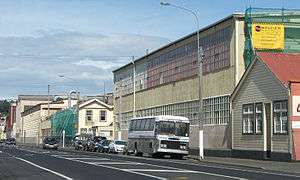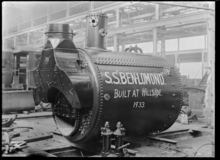Hillside Engineering
Hillside Engineering Group is a trading division of the rail operator KiwiRail in Dunedin, New Zealand.[1] Most of its work is related to KiwiRail, but it also does work for the marine industry in Dunedin. On 19 April 2012 KiwiRail announced it was putting Hillside on the market for sale.[2] In November 2012 KiwiRail announced it had sold part of the business to Australian firm Bradken, and the rest would be closed.[3] The workshops continued to be used for some maintenance work by Kiwirail with a skeleton staff. In October 2019, the New Zealand Government announced that it would be investing NZ$20 million into revitalising Hillside Engineering as a major mechanical hub and engineering facility to service Kiwi Rail's locomotives and rollingstock.[4][5][6]

History

Hillside was founded as the Hillside Workshops of the New Zealand Railways Department in 1901, though workshops had existed close to the current site in South Dunedin since 1875.[1] The workshops were extensively enlarged in the late 1920s, and by 1935 employed 800 workers, compared with 365 workers in 1925. At that stage they were the largest railway workshops in the South Island, covering 16 acres (65,000 m2). By 1945 staff numbers had been reduced to 550.
The workshops, in Hillside Road, were one of South Dunedin's biggest employers and most imposing structures. One of the ends of the nearby Carisbrook sports ground is known as "The Hillside End" or "The Workshops End" due to the presence of the stadium's larger neighbour.
Passenger Car Projects
During 2003 Hillside won the contract to refurbish several old retired Queensland Rail SX cars, that were purchased from the Zig Zag Railway in Australia. The project lasted 14 weeks, after which the refurbished cars were sent to Auckland, where they are used on commuter trains, with a DBR diesel locomotive at each end.
In 2004, Hillside started work on rebuilding imported British Rail Mark 2 passenger cars for use in Auckland on commuter trains. The cars were stripped and rebuilt, for use in a push-pull consist, with a cab control car at one end (classed SD), with several standard cars (classed SA) in between and a diesel locomotive providing motive power at the other end (either a DC or DFT). A diesel generator which provides on board electrical power is fitted into a noise insulated compartment in each SD car. The SA/SD rebuilding project ended in 2010.
In 2009 KiwiRail announced that Hillside Engineering had won the contract to build 17 new passenger cars for its two South Island long distance passenger trains, the TranzAlpine and the Coastal Pacific, classed AK. Part of the project also includes converting 6 existing AG vans into 2 open-air viewing vans and 4 luggage vans. In November 2011, the new cars entered service on the Coastal Pacific.
Sale and closure
In November 2012 KiwiRail announced it had sold part of the business to Australian firm Bradken, and the rest would be closed.[3] Ninety jobs were lost. The opposition Labour Party said the sale was a "political decision", but KiwiRail said there wasn't enough work to keep the workshop operating.[7] Hillside had earlier lost a contract to build new wagons for KiwiRail after it was revealed that it was not competitive and would not be able to deliver the wagons within the time frame specified. KiwiRail have said they intend to allocate some work to the new owners, while other work will be done at the company's Hutt workshops near Wellington.
2019 Upgrade and Re-opening
In the intervening years, Hillside Engineering's workshops continued to be used for some locomotive and wagon maintenance work by KiwiRail with a skeleton staff for overflow work from the KiwiRail Hutt Railway Workshops and maintenance and conversion work on South Island rolling stock. On 30 October 2019, Regional Development Minister Shane Jones announced that the Government would be investing $20 million into re-establishing Hillside workshop as a mechanical hub and heavy engineering facility to service KiwiRail's locomotives and rolling stock. This investment involves upgrading the two main workshop buildings and overhauling the mechanical plant.[4][5][6]
Locomotives classes built at Hillside
Many locomotive classes were built at Hillside:
- DSC
- C (1930) (12)
- JA (35)
- KB (6)
- L
- WA (6)
- WAB (20)
- WF (16)
- WG (20)
- WW (48)
- TR (9) (1973–78, Diesel shunters)
Hillside also rebuilt the following locomotive classes:
See also
- New Zealand British Rail Mark 2 carriage, rebuilt at Hillside Workshops and Hutt Workshops from British Railways Mark 2 carriages
- NZR Addington Workshops, Christchurch
- NZR Hutt Workshops, Lower Hutt/Wellington
- NZR Newmarket Workshops Auckland then Otahuhu Workshops, Auckland
- New Zealand Railways Department
References
- "Hillside's $39.9 million boost". Otago Daily Times. 3 March 2009. Retrieved 3 March 2009.
- "KiwiRail Putting Hillside Workshops Up for sale". Radio New Zealand. 19 April 2012.
- "Jobs to go at KiwiRail after partial sale". 3 News NZ. 15 November 2012. Archived from the original on 11 November 2013. Retrieved 15 November 2012.
- McNeilly, Hamish (30 October 2019). "Dunedin projects secure multimillion-dollar Provincial Growth Fund investment". Stuff.co.nz. Retrieved 31 October 2019.
- Loughrey, David (30 October 2019). "$20m to revitalise 'vital' Hillside Workshop". Otago Daily Times. Retrieved 31 October 2019.
- "PGF payout: Dunedin gets $40m for Hillside workshop, waterfront". Radio New Zealand. 30 October 2019. Retrieved 31 October 2019.
- "Government blamed for Hillside closure". 3 News NZ. 16 November 2012.
Further reading
- Dougherty, Ian (2015). More Than Just a Place to Work: a History of Dunedin's Hillside Railway Workshops. ISBN 9780908573912.